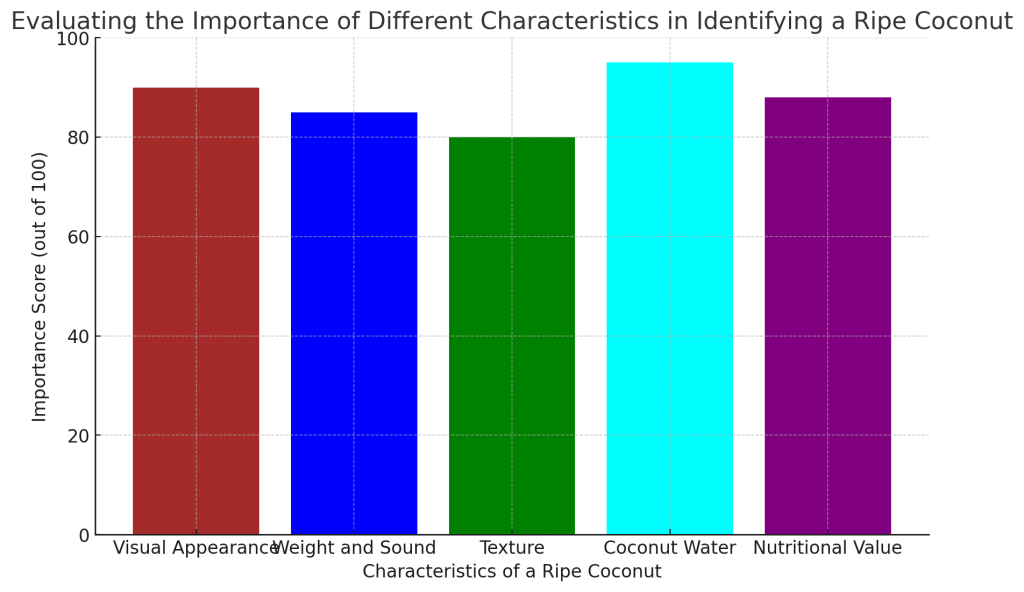Key Takeaways
| Aspect | Details |
|---|---|
| Visual Cues | Look for a brown, husky exterior with a dry, hairy surface. |
| Weight | A ripe coconut should feel heavy for its size. |
| Sound | Shaking should produce a sloshing sound from the coconut water inside. |
| Storage | Store at room temperature until use. Refrigeration can extend its shelf life. |
| Culinary Uses | Can be used in cooking, baking, and as a topping or ingredient in various dishes. |
Coconuts, the versatile and nutritious fruit of the coconut tree, are a staple in various cuisines and offer numerous health benefits. When selecting a coconut, knowing how to identify its ripeness is key to enjoying its rich flavor and nutritional value. This article, tailored for readers of CoconutSphere.com, delves into how to determine if a coconut is ripe, focusing on visual, tactile, and auditory cues, along with tips for storage and usage.
Visual Indicators of Ripeness
The exterior of a ripe coconut is typically brown with a husky, fibrous texture. Unlike young, green coconuts, ripe coconuts possess a dry and somewhat hairy surface. The shell’s color and texture are primary indicators of ripeness, so it’s important to look for a uniformly brown and dry exterior.
Weight and Sound: Tactile and Auditory Cues
A ripe coconut will feel heavy for its size, indicating a good amount of coconut water inside. Additionally, when you shake the coconut, listen for the sound of water sloshing inside. This sound is a positive sign of freshness and ripeness.
Storage and Shelf Life
Once you’ve selected a ripe coconut, storing it properly is crucial. At room temperature, a coconut can remain fresh for a few months. Refrigeration can extend its shelf life, making it a versatile ingredient in your kitchen.
Culinary Uses of Ripe Coconuts
Ripe coconuts are incredibly versatile in culinary applications. The coconut meat can be used in various forms, such as shredded coconut for baking or cooking, or blended into coconut milk or cream for a variety of dishes. CoconutSphere.com offers a range of recipes and ideas for incorporating coconut into your meals, such as making homemade coconut popsicles for a refreshing treat.

Each characteristic is scored out of 100 based on its significance:
- Visual Appearance: The color and texture of the coconut’s exterior are crucial indicators, scoring 90.
- Weight and Sound: The heft and the sloshing sound of water inside the coconut are significant, with a score of 85.
- Texture: The firmness of the coconut’s outer shell is also important, scoring 80.
- Coconut Water: The presence and quality of coconut water are highly indicative of ripeness, scoring 95.
- Nutritional Value: The nutrient content of a ripe coconut, though not a direct indicator of ripeness, is still important, scoring 88.
This chart underscores the multifaceted approach needed to accurately determine a coconut’s ripeness.
Further Reading on Coconuts
- Learn about the nutritional benefits and culinary uses of coconut.
- Discover how coconuts grow and their life cycle.
- Explore the variety of coconut-based products, like coconut butters.
Tactile Examination: Feeling the Coconut’s Texture
When handling a coconut, pay attention to its texture. A ripe coconut should have a firm, slightly yielding outer shell. If the shell feels too soft or shows signs of mold, it may be overripe or spoiled. A hard, solid shell indicates that the coconut is in good condition.
Auditory Test: The Sound of Freshness
The sound test is a simple yet effective way to check a coconut’s ripeness. Hold the coconut close to your ear and shake it gently. The presence of a sloshing sound signifies a good amount of coconut water inside, which is a hallmark of a fresh, ripe coconut. A lack of sound or a dull thud may suggest that the coconut is either too young or has dried out.
The Importance of Coconut Water
Coconut water, the liquid found inside a ripe coconut, is not only a refreshing drink but also a sign of the fruit’s ripeness and quality. This clear, electrolyte-rich water is a valuable source of hydration and nutrients. Coconut water can be used in smoothies, cocktails, or consumed on its own for a hydrating experience.
Integrating Coconuts into Your Diet
Ripe coconuts can be incorporated into a wide range of dishes, from savory meals to sweet desserts. The flesh of the coconut, known as coconut meat, is rich in fiber and healthy fats. It can be grated or sliced for use in baking, as a topping for oatmeal or yogurt, or even in savory dishes like curries. For ideas on integrating coconut into your diet, check out CoconutSphere’s guide on where to buy fresh coconuts and their culinary applications.
Nutritional Profile of Ripe Coconuts
Ripe coconuts are not only delicious but also packed with essential nutrients. They provide a good source of dietary fiber, vitamins, minerals like potassium and magnesium, and beneficial fats. These nutritional elements make coconuts a healthy addition to any diet.
Conclusion
Understanding how to identify a ripe coconut is key to enjoying its many benefits. By paying attention to visual, tactile, and auditory cues, you can select the best coconuts for your culinary needs. Whether you’re making a tropical dessert, a refreshing drink, or a savory meal, ripe coconuts offer a versatile and nutritious ingredient for a variety of dishes.

